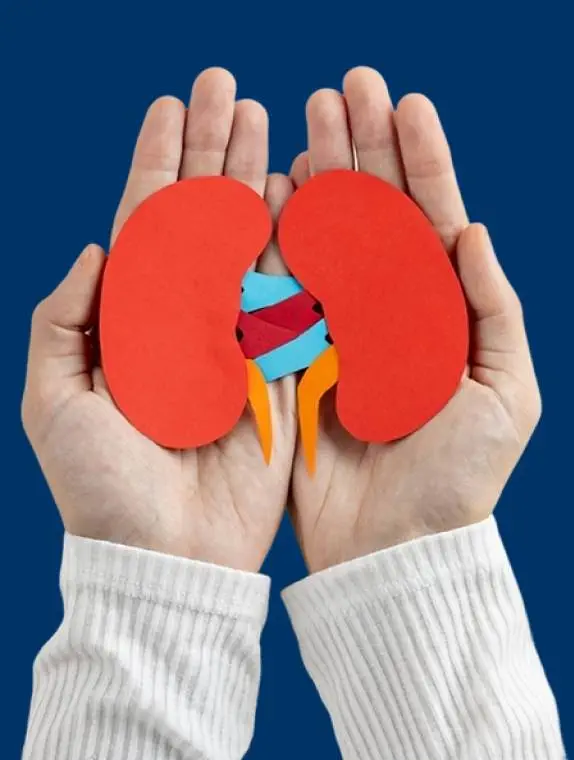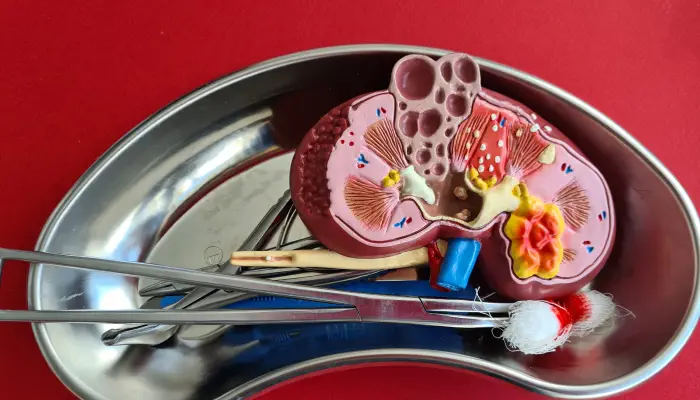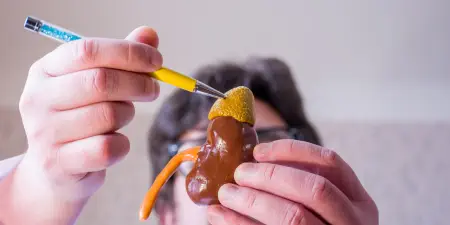Robotic-Assisted Adrenalectomy

Robotic Adrenalectomy: An Advanced Excision of the Adrenal Glands
A host of ailments may require the removal of your adrenal glands. Current medical advancements have made it possible to excise the glands with minimally invasive procedures like Robotic-Assisted Adrenalectomy.
This high-tech surgery requires an expert like Dr. Aarthy P, Chennai’s leading robotic and laparoscopic urologist who specialises in handling the da Vinci System or the advanced robotic surgical device. Apart from years of training and experience, her personalised approach to urological treatments has made Dr. Aarthy one of the most sought-after surgeons in this field.
Robotic adrenalectomy is a minimally invasive procedure to remove the adrenal glands positioned on top of the kidneys. These glands produce hormones governing critical body functions such as blood pressure, metabolism, and response to stress. In some cases, non-cancerous tumours may develop in the adrenal glands, causing abnormally excess hormone production, which may lead to harmful health conditions.
Fortunately, with Dr Aarthy’s compassionate care and medical guidance, you can regain your health and return to your routine life.
When is Robotic Adrenalectomy Necessary?
After a thorough checkup, Dr. Aarthy may recommend robotic adrenalectomy for the following medical issues:
Gain Freedom From Adrenal Gland Issues

- Before Surgery
- What to Expect?
- Post-Surgical Care
Robotic Adrenalectomy: Preparatory Guidelines
Similar to other surgical procedures, a successful robotic adrenalectomy depends on accurate preparation protocols. Here’s what you should do before the procedure:
Complete your pre-surgical appointments with your doctor and take all the necessary tests suggested by your surgical team.
Discontinue certain medications for the specific period suggested by your doctor. The list includes prescription anticoagulants, blood thinners, over-the-counter painkillers and fish oil tablets.
Avoid food and liquid intake after midnight the day before your surgery to ensure a smooth and uncomplicated procedure.
Take your home medications as instructed by your doctor with a small amount of water on the morning of your surgery.
Robotic Adrenalectomy Procedure: What to Expect?
Robotic adrenalectomy is a cutting-edge surgical technique that focuses on precision while prioritising patient comfort. Here’s a summary of the surgical process:
The procedure will commence with the administration of general anaesthesia by a certified anaesthesiologist to ensure you are completely unconscious throughout the procedure, which may last for 2-3 hours.
Your uro surgeon will make 3-5 small incisions in your abdomen to enable access to surgical instruments and a high-definition camera.
Your abdominal cavity is inflated with carbon dioxide gas to help the surgeon visualise the surgical site and to create a space for them to work on.
The robotic arms are connected to the ports, enabling the surgeon to precisely operate instruments and scale movements from a console.
The 3D camera inserted into the abdomen relays crystal-clear images of the surgical site, enabling your surgeon to locate the adrenal glands with pinpoint precision.
Relying on the high-definition images, your surgeon will meticulously separate the affected adrenal gland, carefully avoiding any damage to the surrounding tissues, kidney, and major blood vessels.
The separated adrenal gland is placed in a sterile bag and gently removed via one of the small abdominal incisions.
Your surgeon will prepare to close the incisions by releasing the carbon dioxide and removing the robotic instruments. The incisions will then be carefully sutured and sealed to minimise the risk of scarring and hernias.
Robotic Adrenalectomy Surgery: Post-Surgical Care
Uro surgeons recommend robotic adrenalectomy because it is quicker and less painful compared to conventional surgeries. Here’s what you should expect and follow during your recovery period:
Your doctor may advise you to stay in the hospital for 2-3 days to monitor your hemodynamic stability if your condition calls for it.
You may feel mild to moderate pain at the incision site. Your doctor will recommend pain medication to manage your discomfort and reduce the usage as you feel better.
Restart your food intake with liquid food and slowly transition to a regular diet within 2-3 days, depending on your body’s tolerance to food.
Commence walking from the very next day post-surgery to facilitate blood circulation, promote recovery, and prevent blood clots.
Keep your wound dressing dry and clean. Do not apply heavy lotions until the incisions are fully healed.
Avoid strenuous activities and heavy lifting for at least 4-6 weeks post-surgery. However, you can gradually indulge in light work and gentle stair climbing as you recover.
Make sure to attend follow-up appointments as scheduled by your doctor to assess your recovery and discuss pathology results.
Robotic Adrenalectomy: The Benefits

Easy Approach
Minimally invasive surgery has smaller incisions, which causes less damage to internal tissues, less scarring, and negligible pain.
Enhanced Precision
Advanced robotic systems with robotic arms mimic the surgeon’s hand movements, thus enabling greater precision and better control while excising the gland.
Crystal-Clear Visuals
The high-definition camera provides an enlarged, three-dimensional view of the surgical site. This clarity allows the surgeon to differentiate the tumour from the surrounding organs and tissues.
Minimum Blood Loss
Smaller incisions cause less damage to the internal tissue and significantly lower the risk of blood loss during the surgery.
Low Infection Risk
Smaller incisions, less intrusion, and tiny sutures minimise the likelihood of post-surgical infections.
Faster Recovery
Quick-healing sutures and minimal infection risk lead to shorter hospitalisations, speedier recovery, and expedited returns to routine life.
Less Tissue Damage
Advanced robotic technology allows only minimal intrusion in the internal tissues, thus minimising any damage to the adjacent blood vessels and organs.
Prioritise Your Adrenal Health





